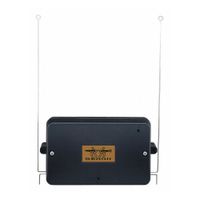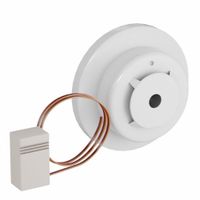Call +(254) 703 030 000 / 751 483 999 / 721 704 777
- Home
- Security
- Security Alarms Warnings
- Security Systems
.....Read More
Frequently Asked Questions
What are the different types of sensors used in security systems?
Security systems utilize a variety of sensors to detect unauthorized access, environmental changes, or potential threats. Here are some common types:
1. **Motion Sensors**: Detect movement within a specified area. They use technologies like infrared, microwave, or ultrasonic waves to sense motion.
2. **Door/Window Sensors**: Composed of a magnet and a sensor, these devices trigger an alarm when the magnetic connection is broken, indicating a door or window has been opened.
3. **Glass Break Sensors**: Detect the sound or vibration of breaking glass, alerting the system to potential intrusions through windows.
4. **Smoke Detectors**: Identify smoke particles in the air, providing early warning of a fire. They can be ionization or photoelectric types.
5. **Heat Sensors**: Detect rapid increases in temperature, which may indicate a fire, and are often used in conjunction with smoke detectors.
6. **Carbon Monoxide Detectors**: Sense the presence of carbon monoxide gas, which is colorless and odorless, to prevent poisoning.
7. **Vibration Sensors**: Detect vibrations or shocks, often used on safes or walls to sense tampering or forced entry.
8. **Pressure Sensors**: Measure changes in pressure, useful for detecting unauthorized entry through floors or ceilings.
9. **PIR Sensors (Passive Infrared)**: Detect body heat and movement, commonly used in motion detectors.
10. **Ultrasonic Sensors**: Emit ultrasonic waves and measure the reflection to detect movement or changes in the environment.
11. **Microwave Sensors**: Use microwave pulses to detect motion, often used in combination with other sensors for enhanced accuracy.
12. **Photoelectric Beams**: Use light beams to detect intrusions when the beam is broken.
13. **Water/Flood Sensors**: Detect the presence of water, useful for preventing water damage in basements or near appliances.
These sensors are often integrated into comprehensive security systems to provide layered protection and ensure rapid response to potential threats.
How do security system control panels and keypads work?
Security system control panels and keypads are integral components of a security system, working together to monitor and manage security devices. The control panel acts as the system's brain, processing signals from various sensors and devices like motion detectors, door/window contacts, and cameras. It is typically installed in a secure location and connects to these devices via wired or wireless communication.
The control panel is responsible for arming and disarming the system, processing alerts, and communicating with monitoring services or the user. It can send alerts via phone lines, cellular networks, or internet connections to notify users or monitoring centers of security breaches.
Keypads serve as the user interface for the security system, allowing users to input commands, such as arming or disarming the system, and to receive system status updates. They are usually installed near entry points for easy access. Keypads can be physical devices with buttons or touchscreens, or virtual interfaces accessed via mobile apps.
When a user inputs a command on the keypad, it sends a signal to the control panel, which then executes the command. If a sensor is triggered, the control panel evaluates the signal and determines the appropriate response, such as sounding an alarm or notifying the user or monitoring service.
Advanced systems may include features like voice recognition, biometric access, and integration with smart home devices, enhancing both security and convenience. Overall, the control panel and keypad work in tandem to ensure the security system operates effectively, providing users with control and peace of mind.
What is the role of networking devices in a security system?
Networking devices play a crucial role in a security system by facilitating communication, data transfer, and connectivity between various components. They ensure that security systems operate efficiently and securely. Key roles include:
1. **Data Transmission**: Networking devices like routers, switches, and hubs enable the transmission of data between security devices such as cameras, sensors, and control panels. They ensure that data flows seamlessly across the network.
2. **Segmentation and Isolation**: Firewalls and VLANs (Virtual Local Area Networks) help segment the network, isolating sensitive security data from other network traffic. This reduces the risk of unauthorized access and potential breaches.
3. **Access Control**: Devices like firewalls and access points enforce security policies by controlling which devices can access the network. They authenticate users and devices, ensuring only authorized entities can interact with the security system.
4. **Monitoring and Management**: Network management devices and software provide real-time monitoring of network traffic and device status. They help in detecting anomalies, potential threats, and ensuring the health of the security system.
5. **Redundancy and Reliability**: Networking devices support redundancy protocols like STP (Spanning Tree Protocol) and failover mechanisms to ensure continuous operation of security systems, even in case of device failure.
6. **Encryption and VPNs**: Devices like VPN routers encrypt data transmitted over the network, protecting sensitive information from interception and ensuring secure remote access to the security system.
7. **Integration and Scalability**: Networking devices facilitate the integration of various security components and support scalability, allowing the security system to expand as needed without compromising performance or security.
Overall, networking devices are integral to the functionality, security, and reliability of modern security systems, ensuring they operate effectively in protecting assets and information.
How do security systems detect intruders?
Security systems detect intruders using a combination of sensors, cameras, and software algorithms. Motion detectors, which use infrared, microwave, or ultrasonic technology, sense movement within a designated area. Infrared sensors detect changes in heat, while microwave sensors emit radio waves and measure the reflection off moving objects. Ultrasonic sensors use sound waves to detect motion.
Door and window sensors, often magnetic, trigger an alarm when the magnetic connection is broken, indicating a possible breach. Glass break detectors use acoustic sensors to identify the specific frequency of breaking glass.
Cameras equipped with video analytics software can identify unusual activities or unauthorized individuals. These systems use facial recognition, object detection, and behavioral analysis to differentiate between normal and suspicious activities. Some advanced systems employ artificial intelligence to improve accuracy over time.
Pressure sensors, often embedded in floors or mats, detect weight changes, indicating someone stepping on them. Vibration sensors can be attached to walls or fences to detect tampering or forced entry attempts.
Perimeter security systems use laser beams or infrared light to create an invisible boundary. When the beam is interrupted, an alarm is triggered. Similarly, electric fences can detect intrusions through changes in electrical current.
Audio sensors can pick up unusual sounds, such as breaking glass or forced entry noises, and trigger alerts. In some systems, environmental sensors detect changes in temperature, humidity, or air quality, which may indicate an intrusion.
All these sensors and devices are typically connected to a central control panel, which processes the data and determines whether an alarm should be triggered. Many modern systems also offer remote monitoring, allowing users to receive alerts and view live camera feeds via smartphones or computers.
What are the benefits of integrating smoke, heat, and gas sensors into a security system?
Integrating smoke, heat, and gas sensors into a security system offers several benefits that enhance safety and protection. Firstly, these sensors provide early detection of potential hazards. Smoke sensors can identify the presence of smoke from fires, while heat sensors detect abnormal temperature rises, and gas sensors identify harmful gases like carbon monoxide. Early detection allows for prompt alerts, enabling swift evacuation and emergency response, potentially saving lives and minimizing property damage.
Secondly, these sensors contribute to comprehensive monitoring. By integrating them into a security system, users can monitor environmental conditions in real-time, ensuring a holistic approach to safety. This integration allows for centralized control and management, simplifying the process of monitoring and responding to various threats.
Thirdly, the integration enhances automation and connectivity. Modern security systems can be connected to smart home devices, allowing for automated responses such as shutting off gas valves or activating ventilation systems when a gas leak is detected. This connectivity also enables remote monitoring and control via smartphones or other devices, providing peace of mind even when away from the premises.
Additionally, integrating these sensors can lead to cost savings. Early detection and automated responses can prevent extensive damage, reducing repair and insurance costs. Some insurance companies may also offer discounts for properties equipped with comprehensive security systems, further lowering expenses.
Finally, the integration of smoke, heat, and gas sensors into a security system can improve compliance with safety regulations and standards, ensuring that buildings meet necessary safety requirements and reducing the risk of legal liabilities.
In summary, integrating these sensors enhances safety through early detection, comprehensive monitoring, automation, cost savings, and regulatory compliance, making it a valuable addition to any security system.
How can I ensure my security system is properly connected and communicating?
1. **Check Power Supply**: Ensure all components are properly powered. Verify that batteries are charged and power cables are securely connected.
2. **Network Connection**: Confirm that your security system is connected to the internet. Check Wi-Fi or Ethernet connections and ensure the router is functioning properly.
3. **Device Configuration**: Access the system’s control panel or app to verify that all devices are correctly configured and recognized by the system.
4. **Signal Strength**: For wireless systems, check the signal strength between devices and the central hub. Relocate devices or use range extenders if necessary.
5. **Firmware Updates**: Regularly update the system’s firmware to ensure compatibility and security. Check the manufacturer’s website or app for updates.
6. **Test Communication**: Perform regular tests to ensure all sensors, cameras, and alarms are communicating with the central system. Use the system’s test mode if available.
7. **Notifications and Alerts**: Set up and verify that notifications and alerts are properly configured to be sent to your phone or email.
8. **Backup Systems**: Ensure backup systems, like cellular backup or battery backup, are in place and functioning in case of power or internet failure.
9. **Professional Monitoring**: If using a professional monitoring service, confirm that they are receiving signals from your system and responding appropriately.
10. **User Access**: Regularly update passwords and review user access settings to ensure only authorized individuals can access the system.
11. **Physical Inspection**: Periodically inspect all physical components for damage or tampering.
12. **Consult Documentation**: Refer to the user manual or manufacturer’s support for specific troubleshooting steps and best practices.
13. **Professional Assistance**: Consider hiring a professional to assess and optimize your system’s setup and connectivity.
What are the best practices for maintaining and updating a security system?
1. **Regular Updates and Patching**: Ensure all software and firmware are up-to-date. Apply patches promptly to fix vulnerabilities.
2. **Access Control**: Implement strict access controls. Use multi-factor authentication and limit access to sensitive areas to authorized personnel only.
3. **Monitoring and Logging**: Continuously monitor systems for unusual activity. Maintain logs for auditing and forensic analysis.
4. **Data Encryption**: Encrypt sensitive data both in transit and at rest to protect against unauthorized access.
5. **Backup and Recovery**: Regularly back up data and test recovery procedures to ensure business continuity in case of a breach.
6. **Security Training**: Conduct regular training sessions for employees to recognize and respond to security threats like phishing.
7. **Incident Response Plan**: Develop and regularly update an incident response plan to quickly address and mitigate security breaches.
8. **Network Security**: Use firewalls, intrusion detection/prevention systems, and secure network configurations to protect against external threats.
9. **Physical Security**: Ensure physical security measures are in place, such as surveillance cameras and secure access points.
10. **Vendor Management**: Assess and monitor third-party vendors for compliance with security standards.
11. **Vulnerability Assessments**: Conduct regular vulnerability assessments and penetration testing to identify and address potential weaknesses.
12. **Policy and Compliance**: Maintain up-to-date security policies and ensure compliance with relevant regulations and standards.
13. **User Awareness**: Promote a culture of security awareness among users to prevent accidental breaches.
14. **Review and Audit**: Regularly review and audit security measures to ensure effectiveness and compliance with best practices.



